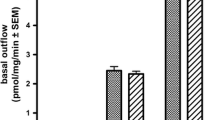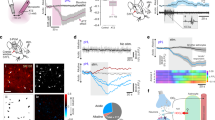Abstract
Uptake of glutamate into glial cells in the CNS maintains the extracellular glutamate concentration below neurotoxic levels and helps terminate its action as a neurotransmitter 1. The co-transport of two sodium ions on the glutamate carrier is thought to provide the energy needed to transport glutamate into cells2,3. We have shown recently that glutamate uptake can be detected electrically because the excess of Na+ ions transported with each glutamate anion results in a net current flow into the cell4. We took advantage of the control of the environment, both inside and outside the cell, provided by whole-cell patch-clamping and now report that glutamate uptake is activated by intracellular potassium and inhibited by extracellular potassium. Our results indicate that one K+ ion is transported out of the cell each time a glutamate anion and three Na+ ions are transported in. A carrier with this stoichiometry can accumulate glutamate against a much greater concentration gradient than a carrier co-transporting one glutamate anion and two Na+ ions. Pathological rises in extracellular potassium concentration will inhibit glutamate uptake by depolarizing glial cells and by preventing the loss of K+ from the glutamate carrier. This will facilitate a rise in the extracellular glutamate concentration to neurotoxic levels and contribute to the neuronal death occurring in brain anoxia and ischaemia.
Similar content being viewed by others
References
Hertz, L. Prog. Neurobiol. 13, 277–323 (1979).
Stallcup, W. B., Bulloch, K. & Baetge, E. E. J. Neurochem 32, 57–65 (1979).
Erecinska, M., Troeger, M. B., Wilson, D. F. & Silver, I. A. Brain Res. 369, 203–214 (1986).
Brew, H. & Attwell, D. Nature 327, 707–709 (1987).
Hamill, O. P., Marty, A., Neher, E., Sakmann, B. & Sigworth, F. Pflügers Arch. ges. Physiol. 391, 85–100 (1981).
Kanner, B. I. & Sharon, I. Biochemistry 17, 3949–3953 (1978).
Walz, W. & Hertz, L. Prog. Neurobiol. 20, 133–183 (1983).
Rothman, S. M. & Olney, J. W. Trends Neurosci. 10, 299–302 (1987).
Mayer, M. L. & Westbrook, G. L. Prog. Neurobiol. 28, 197–276 (1987).
Newman, E. A. Nature 317, 809–811.
Author information
Authors and Affiliations
Rights and permissions
About this article
Cite this article
Barbour, B., Brew, H. & Attwell, D. Electrogenic glutamate uptake in glial cells is activated by intracellular potassium. Nature 335, 433–435 (1988). https://doi.org/10.1038/335433a0
Received:
Accepted:
Issue Date:
DOI: https://doi.org/10.1038/335433a0
- Springer Nature Limited
This article is cited by
-
Glia-neuron interactions underlie state transitions to generalized seizures
Nature Communications (2019)
-
PAR1 activation induces rapid changes in glutamate uptake and astrocyte morphology
Scientific Reports (2017)
-
Real-time imaging of glutamate clearance reveals normal striatal uptake in Huntington disease mouse models
Nature Communications (2016)
-
The role of glial-specific Kir4.1 in normal and pathological states of the CNS
Acta Neuropathologica (2016)
-
Ammonia Mediates Methamphetamine-Induced Increases in Glutamate and Excitotoxicity
Neuropsychopharmacology (2014)





